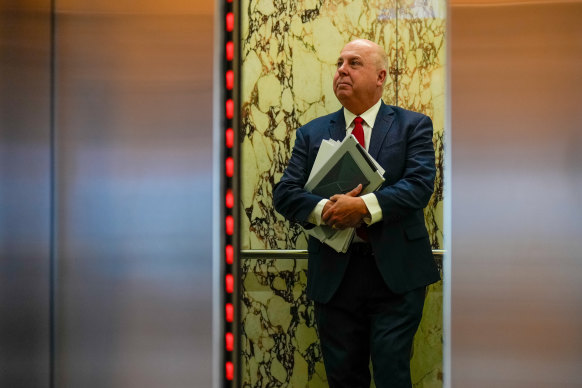This was published 4 months ago
Pallas vows no new debt despite $1.5b health blowout, but stays coy on fresh taxes
By Josh Gordon
Treasurer Tim Pallas has vowed to stop Victoria sliding deeper into debt, warning state ministers to keep a lid on spending or risk another credit rating downgrade.
In a sign that Victoria’s path out of financial strife is increasingly precarious, the government is desperately searching for savings or extra revenue to offset a $1.5 billion emergency hospital funding bailout.

Treasurer Tim Pallas has warned state ministers to keep spending under control.Credit: Getty
On Wednesday, Pallas said the government still believed it had “breathing space” to protect Victoria’s credit rating. But he warned a failure to shore up the state’s financial position, including bringing down debt, could have serious consequences.
“We have to be focused in terms of managing the situation because if debt were to go up appreciably, then it wouldn’t be long before a review of our rating would occur.”
Credit rating agency S&P hit Victoria with a double-notch credit rating downgrade during the pandemic in December 2020. That took the state’s rating, which helps determine the cost of borrowing money, to the lowest among the states.
Pallas said mapping out a plan in Victoria’s upcoming budget update to pay for the health funding top-up – which he linked to record demand for health services and booming population growth – would be challenging.
“As you would appreciate, $1.5 billion is to fill a demand hole for this year – we have to find a strategy … to make sure that that is not repeated next year,” he said.
Asked if higher taxes could be in store, Pallas gave “no assurances” they wouldn’t, but said the government was “very conscious that we’re in the middle of a cost-of-living crisis”.
“The treasurer of the state does get a little bit unhappy when I’m presented with short payments in budget management,” he said. “But I do make a point to the health minister and to others, we really do return to the level of fiscal responsibility and attention to financial obligations that was pretty much part and parcel of the pre-COVID era.”
The comments come amid simmering tensions within the government over the state of the budget.
Premier Jacinta Allan has come under pressure over health funding, after instructing the state’s 76 health services to rein in spending.
At the same time, Pallas has insisted his so-called five-step fiscal strategy out of financial strife – including the reduction of debt as a proportion of the state economy – is non-negotiable.
With net debt expected to peak at $187.8 billion by the middle of 2028 – equivalent to about one-quarter of the state economy – the government has little room left for fiscal manoeuvring.
As it is, the state’s annual interest bill is expected to rise to about $9.4 billion by 2027-28.
The government also remains hemmed in on the revenue side of the equation, having already imposed a number of new taxes in recent years – including the COVID-19 debt levy on property investors and the recent expansion of vacant residential land tax – to shore up the state’s finances.
The economy also remains in a tenuous position. Last week, Reserve Bank assistant governor Sarah Hunter singled out Victoria as an economic underperformer.
“Victoria is really struggling right now as one of the relative underperformers, Tasmania as well,” Hunter told a federal inquiry into cost-of-living pressures. “But equally, we can see Queensland, Western Australia [and] South Australia look like they’re doing a bit better.”
Victoria is also lagging other states on a range of indicators. State final demand – a key measure of total spending excluding exports and imports – limped up by 1.5 per cent in the March quarter compared with a year earlier. That’s the equal lowest – along with Tasmania – of the states.
Victoria’s building sector has been hit particularly hard. Over the year to June, the number of dwellings approved for construction dropped 17.4 per cent – by far the worst result among the states – compared with a national decline of 3.7 per cent.
The state also has the highest unemployment rate – 4.5 per cent in June compared with a national average of 4.1 per cent.
At the same time, hourly rates of pay in Victoria excluding bonuses grew by an average of 3.3 per cent in the June quarter year-on-year, again the lowest of the states and well below the national average of 4.1 per cent.
Shadow Treasurer Brad Rowswell said Pallas’ comments represented a “stunning admission” of economic mismanagement.
“Where will Labor’s service cuts and higher taxes hit Victorians?” he said. “Will Victorians be slapped with higher property and business taxes? Cuts to education, community safety, roads maintenance budgets?
“Victorians deserve better and the Allan Labor government must immediately confirm what will be cut and who will pay more.”
Get the day’s breaking news, entertainment ideas and a long read to enjoy. Sign up to receive our Evening Edition newsletter.